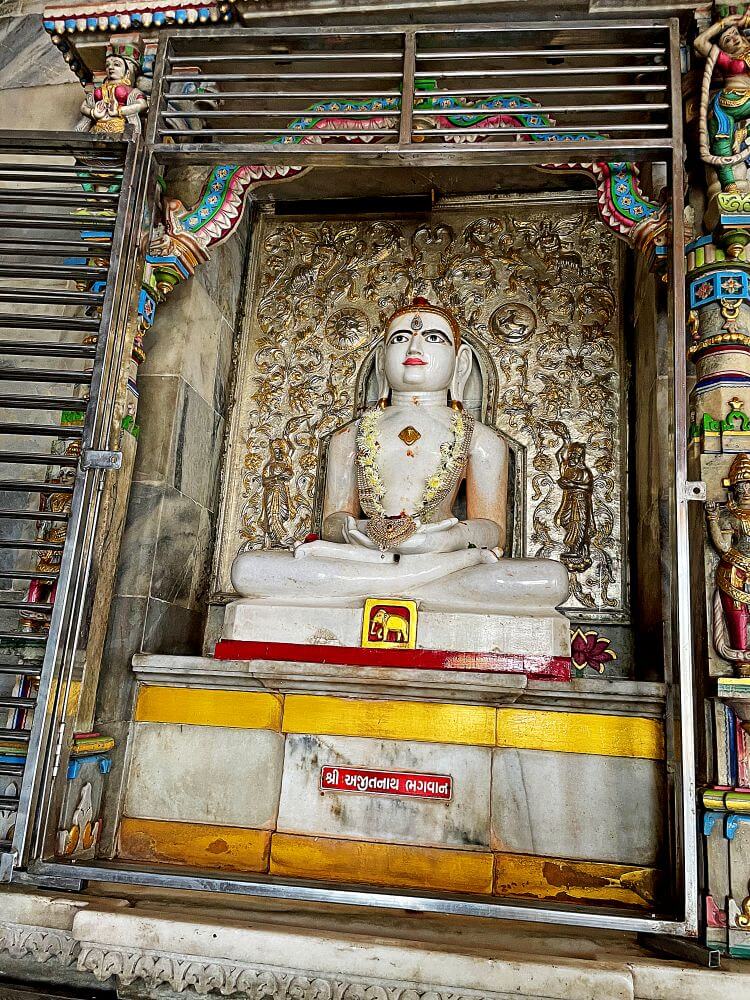 The Dada Bhagwan Temple in Kamrej is a serene spiritual hub, embodying the teachings of Dada Bhagwan, who advocated for universal harmony and non-violence. This spacious temple complex, nestled in a tranquil natural environment, spans several acres and is popularly known as the Trimandir. The concept of the Trimandir unites Jainism, Shaivismand Vaishnavism, offering a space for the worship of Jain deity Simandhar Swami, Lord Krishnaand Lord Shiva. It is a revered place of worship and solace for followers and devotees of Dada Bhagwan.
The Dada Bhagwan Temple in Kamrej is a serene spiritual hub, embodying the teachings of Dada Bhagwan, who advocated for universal harmony and non-violence. This spacious temple complex, nestled in a tranquil natural environment, spans several acres and is popularly known as the Trimandir. The concept of the Trimandir unites Jainism, Shaivismand Vaishnavism, offering a space for the worship of Jain deity Simandhar Swami, Lord Krishnaand Lord Shiva. It is a revered place of worship and solace for followers and devotees of Dada Bhagwan.
Dada Bhagwan, born Ambalal Muljibhai Patel on 7 November 1908 in Tarasali village, Gujarat, was an independent thinker and spiritual leader. After completing basic schooling, he chose not to pursue further education, intending to avoid working under others. Spirituality intrigued him from a young age. Professionally, he moved to Mumbai, where he worked as a contractor with Patel & Company, maintaining dry docks at the Mumbai port.
In June 1958, Dada Bhagwan reportedly experienced a moment of self-realisation while sitting on platform number 3 at Surat railway station. This transformative moment led him to establish the Akram Vignan movement in the 1960s. According to the Dada Bhagwan Foundation, Akram Vignan offers a shortcut to self-realisation, bypassing the traditional requirements of renunciation and self-discipline. 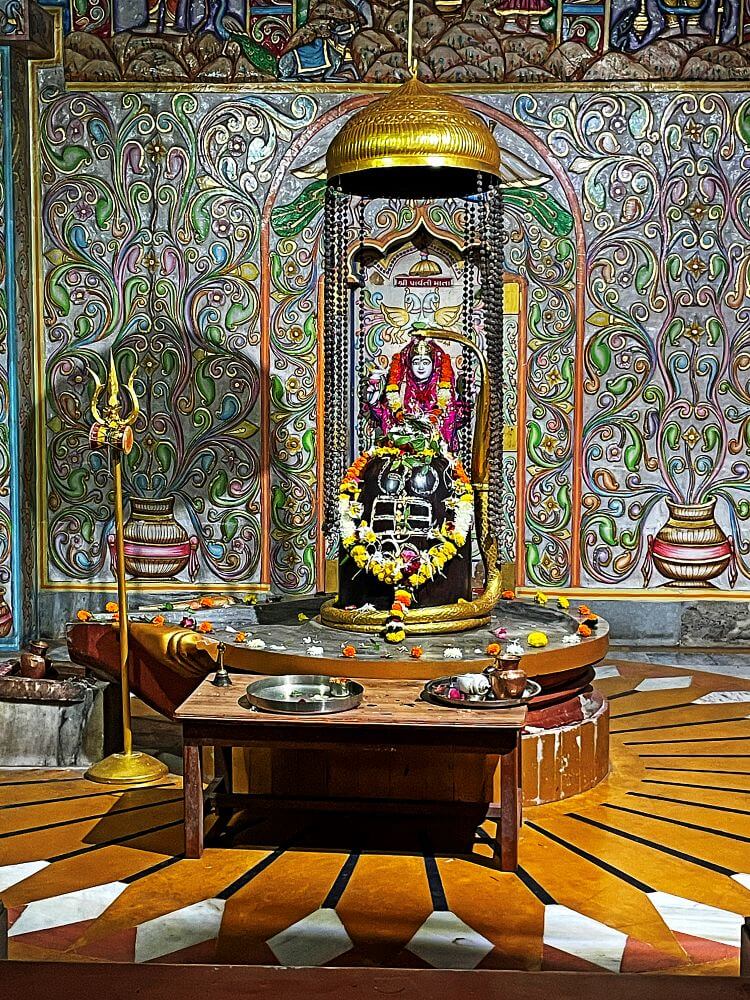 The movement focuses on a process called Gnan Vidhi, where self-knowledge is claimed to be imparted within two hours. Devotion through knowledge, or Gnan Bhakti, is its cornerstone, emphasising spiritual surrender to Simandhar Swami and the teachings of Dada Bhagwan.
The movement focuses on a process called Gnan Vidhi, where self-knowledge is claimed to be imparted within two hours. Devotion through knowledge, or Gnan Bhakti, is its cornerstone, emphasising spiritual surrender to Simandhar Swami and the teachings of Dada Bhagwan.
Jain tradition holds Simandhar Swami as a living Tirthankar (spiritual teacher), residing in Mahavideh Kshetra, a parallel realm. According to Jain beliefs, Simandhar Swami’s physical form is approximately 1,500 feet talland his age is currently believed to be approximately 150,000 yearsand he is said to live for another 125,000 years. It is also mentioned in Jain tradition that King Dasharatha received spiritual initiation (Diksha) from Simandhar Swami. He is regarded as an active spiritual guide. In the Trimandirs constructed by the Dada Bhagwan Foundation, Simandhar Swami is worshipped with great devotion and reverence.
The Trimandir is considered a revolutionary religious concept, offering equal significance to all major faiths. According to the teachings of Dada Bhagwan, People themselves have divided God and religion. Instead of choosing one deity, we should understand and practise the core principles of all religions. All deities have emphasised the importance of the soul and self-realisation. Based on this philosophy, many temples embodying these ideals have been established across various locations, with one such notable temple being the Trimandir in Kamrej.
Set amidst an expansive landscape adorned with gardens and greenery, the Trimandir in Kamrej stands as a serene architectural marvel. Like other Trimandirs, the temples here are situated on the first floor, accessible by a grand staircase of 28 marble steps. The temple complex follows a traditional layout comprising a main assembly hall (sabhamandap), porches (mukhamandap) on three sides, a small inner sanctum (antaral)and the sanctum sanctorum (garbhagriha).
Upon entering the temple premises, visitors are greeted first by the temple dedicated to Yogeshwar Krishna. Adjacent to it is the temple of Simandhar Swamiand the third temple is devoted to Sangameshwar Mahadev. These three temples are interconnected by a walkway, allowing visitors to move seamlessly between the sabhamandaps of each temple.
The mukhamandaps and sabhamandaps are crowned with domes crafted in the Fasana style of architecture, while the main spires of the temples follow the Nagara style’s Uru-Shring design. This style of spire design involves layering smaller spires around and atop a central, dominant spire. Atop these domes sits a large circular amalaka (a ridged stone disc), crowned by a magnificent kalash (pinnacle). The extensive use of marble throughout the construction lends the temples a pristine and majestic appearance.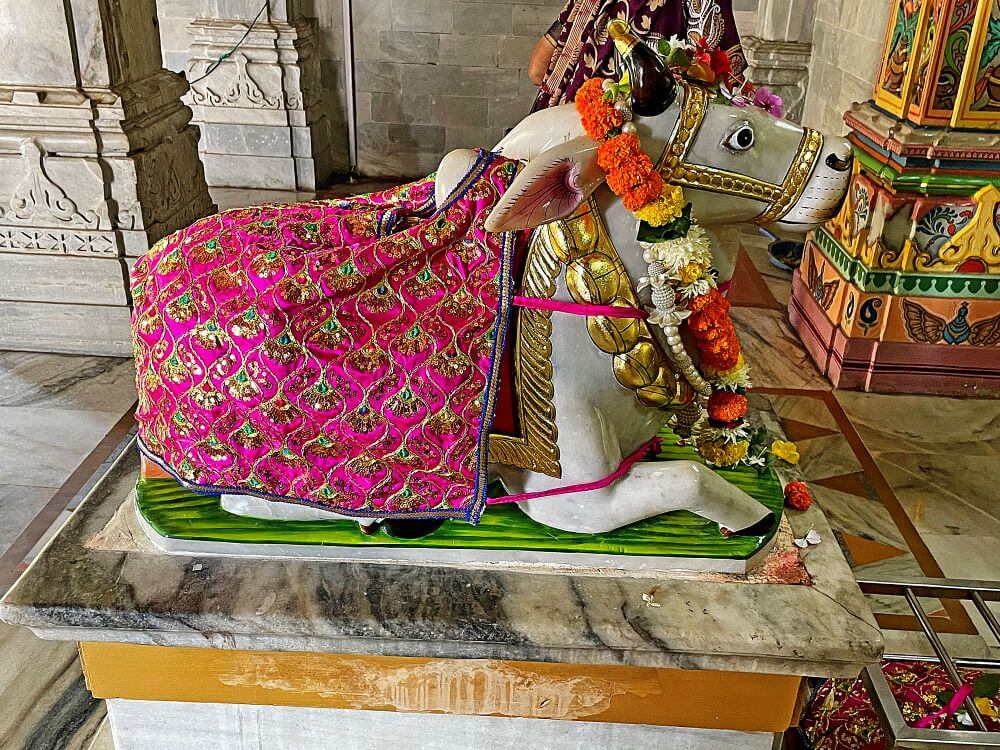
The pillars within the temples showcase exquisite carvings, displaying the artistry and craftsmanship of the region. The external pillars of the mukhamandaps feature intricately carved arches (makartorana), adding a decorative touch to the structure. The entrance pillars are adorned with beautiful sculptures of gatekeepers (dwarapalas) and attendants (dwarasevikas), enhancing the grandeur and sanctity of the complex.
In the Akram Vignan movement, significant importance is also given to the Shaiva sect, alongside other philosophies. A temple dedicated to Shiva, revered as the supreme deity by all Hindus, is prominently featured. The main sanctum houses a grand marble statue of Nandi, Shiva’s devoted vahana (vehicle),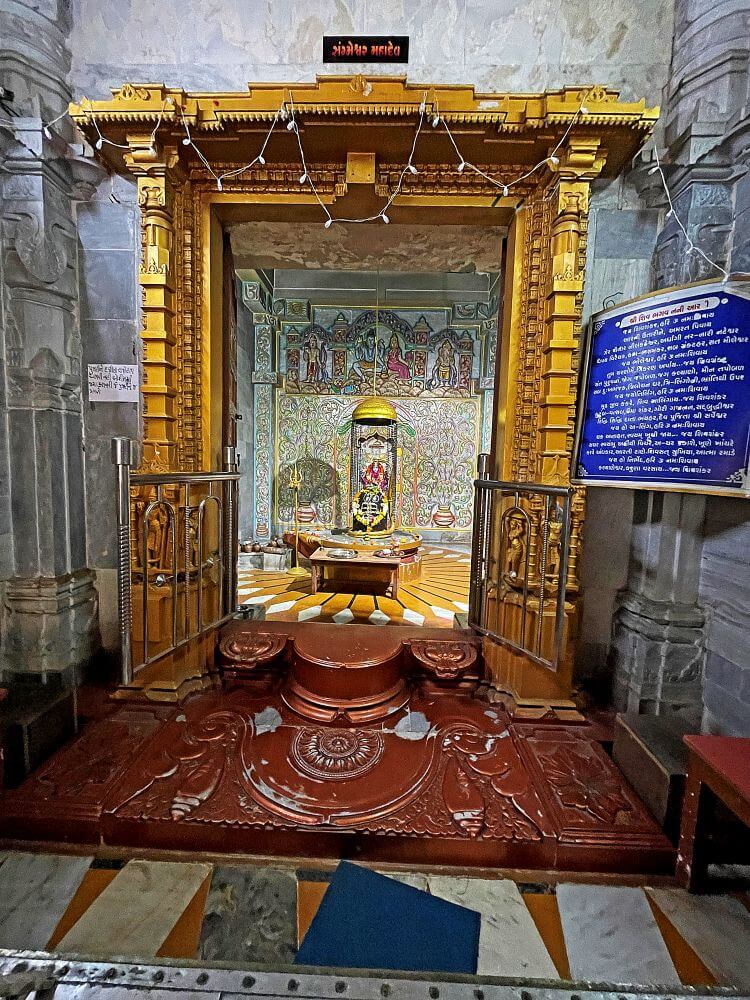 placed on a raised platform in the mandapa (assembly hall). In front of Nandi, there is a marble idol of a tortoise (kasyapa), symbolising stability and support in Hindu cosmology. The antarala (small inner sanctum) is flanked by niches (devakoshtakas) containing beautiful idols of Hanuman and Ganesh. The garbhagriha (sanctum sanctorum) features a golden-framed doorway that leads to a beautifully elevated shalunka, upon which the Shivalinga is enshrined.
placed on a raised platform in the mandapa (assembly hall). In front of Nandi, there is a marble idol of a tortoise (kasyapa), symbolising stability and support in Hindu cosmology. The antarala (small inner sanctum) is flanked by niches (devakoshtakas) containing beautiful idols of Hanuman and Ganesh. The garbhagriha (sanctum sanctorum) features a golden-framed doorway that leads to a beautifully elevated shalunka, upon which the Shivalinga is enshrined.
Adding to the temple’s artistic and spiritual charm, the rear wall of the sanctum is adorned with intricate floral carvings in marble. Above this, a sculpted panel depicting Shiva’s family—including Parvati, Ganeshand Kartikeya—is meticulously carved.
At the heart of the temple dedicated to Simandhar Swami, the garbhagriha houses a magnificent marble idol of the revered Tirthankar. This idol, seated in the meditative Padmasana posture, is elevated on a meticulously crafted pedestal (vedi). The pedestal is adorned with intricate carvings, including a depiction of a bull, which serves as the emblem of Simandhar Swami.
The idol is richly ornamented with gold jewellery, including embellishments on the hands, arms, neckand ears. Atop the idol’s head rests an elaborate golden crown. The pedestal itself features finely sculpted figures of elephants (Gajarajas), lionsand Padmavati Devi.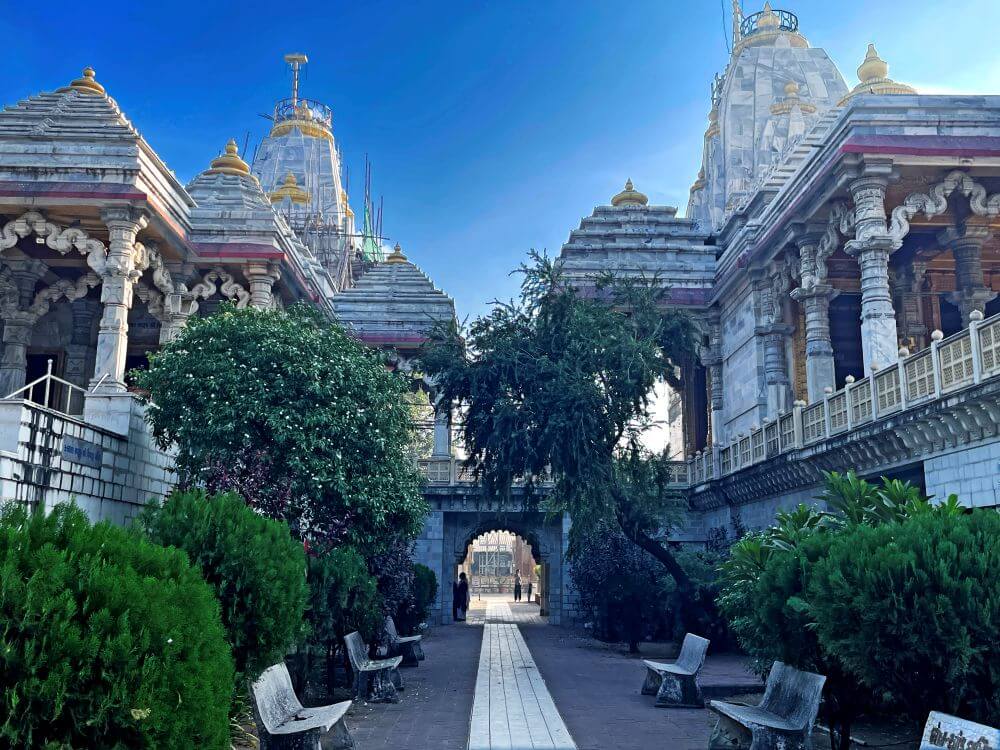
In the temple’s antarala, additional deities associated with Simandhar Swami are enshrined. These include Chandrayana Yaksha and the Swami’s guardian deity (Shashan Devi), Panchanguli Yakshini Devi.
The surrounding sabhamandapa contains exquisitely crafted marble devkoshta, which house idols of other revered Tirthankars and associated deities. These include Bhagwan Parshvanath, Mahavir, Rishabhdev (Adinath), Ajitnathand prominent Jain goddesses such as Chakreshwari Devi and Padmavati Devi. Each idol is sculpted with artistic precision, reflecting the serene and spiritual essence of Jain devotional art.
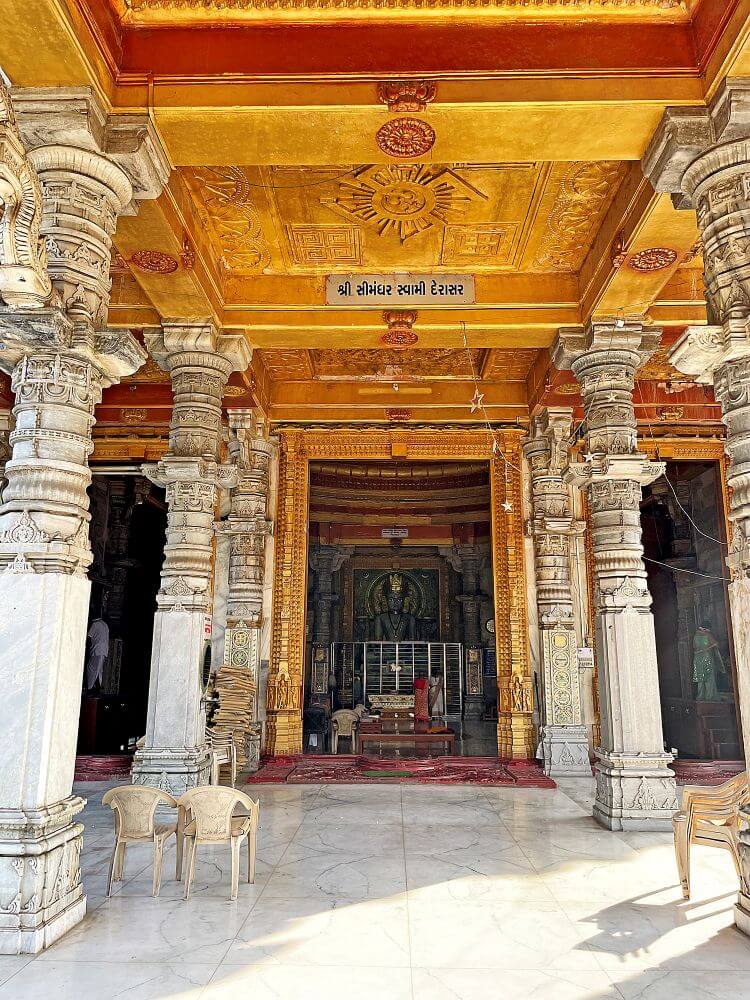 At the Yogeshwar Krishna Temple, the mukhamandapa features a striking black stone idol of Garuda, seated atop a high square pedestal. The sabhamandapa houses devkoshta on its walls, containing idols of Ashtabhuja Ambamata, a fierce eight-armed goddess mounted on a tigerand Chaturbhuja Bhadrakali, a four-armed goddess seated majestically on a lion. Within the garbhagriha, idols of Krishna in his forms as Yogeshwar (the supreme yogi) and Dwarkadhish (the king of Dwarka) are enshrined, exuding divine grace and serenity.
At the Yogeshwar Krishna Temple, the mukhamandapa features a striking black stone idol of Garuda, seated atop a high square pedestal. The sabhamandapa houses devkoshta on its walls, containing idols of Ashtabhuja Ambamata, a fierce eight-armed goddess mounted on a tigerand Chaturbhuja Bhadrakali, a four-armed goddess seated majestically on a lion. Within the garbhagriha, idols of Krishna in his forms as Yogeshwar (the supreme yogi) and Dwarkadhish (the king of Dwarka) are enshrined, exuding divine grace and serenity.
On the ground floor of the Yogeshwar Krishna Temple, a museum dedicated to the life and teachings of Dada Bhagwan displays paintings and artefacts narrating his spiritual journey. Below the Simandhar Swami Temple, an eternal Akhanda Jyoti (everlasting flame) burns in reverence to Dada Bhagwan. The ground floor of the Shiva Temple houses a shrine dedicated to Siddhivinayak Ganesh.
Beyond the main TriMandir complex, additional shrines enhance the spiritual experience. Behind the main temples lies a shrine for Sai Baba, a saint revered for his teachings of universal brotherhood and compassion, alongside the Padmanabha Prabhu Derasar (Temple). Both these smaller temples consist of a modest entrance hall and a sanctum. 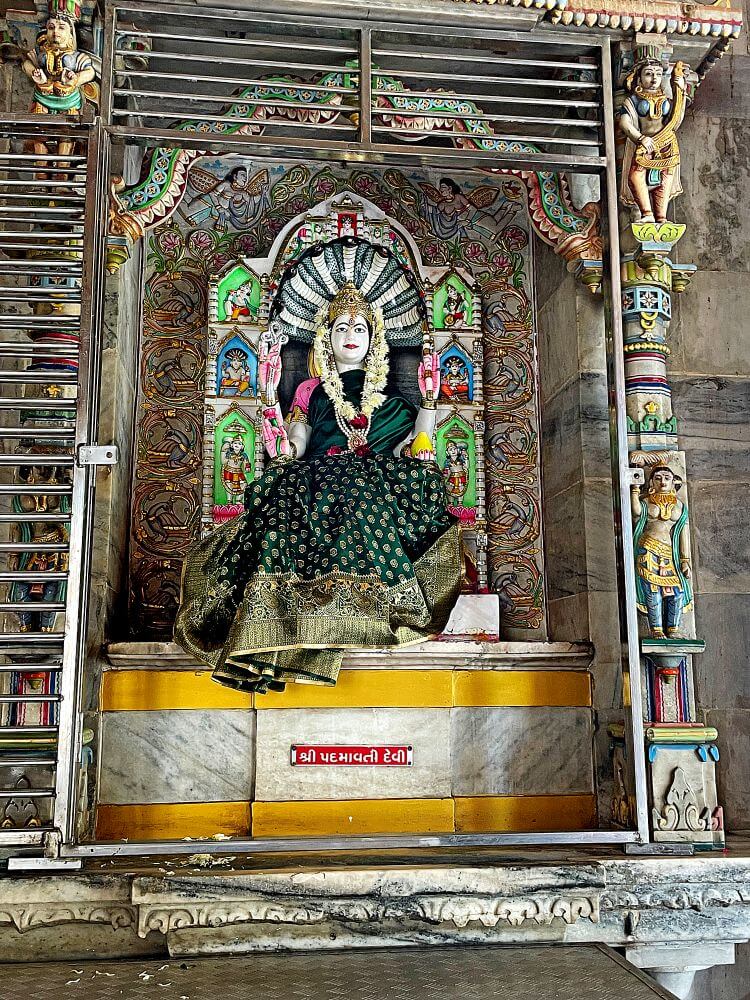 The entrance pavilions of these temples are adorned with smaller pyramidal spires (phansana-style), while the sanctum spires reflect the Nagar-style Uru-Shring architecture, characterised by its stepped, multi-tiered design.
The entrance pavilions of these temples are adorned with smaller pyramidal spires (phansana-style), while the sanctum spires reflect the Nagar-style Uru-Shring architecture, characterised by its stepped, multi-tiered design.
Inside, the temples house exquisite marble idols of Sai Baba and Padmanabha Prabhu, seated in the tranquil Padmasana posture, embodying divine calmness and spiritual resonance.
At the Simandhar Swami Derasar, various sacred rituals such as Snan Puja (ceremonial bathing), Panchkalyanak Puja (a celebration of five auspicious events in a Tirthankara’s life), Siddhachakra Puja (devotion to the sacred Jain cosmic diagram)and Ataraya Karm Nivaran Puja (a ritual to alleviate negative karmic influences) are performed with great reverence.
In the Sangameshwar Mahadev Temple, worshippers engage in Rudrabhishek (ritualistic bathing of the Shivling with holy substances), Bilvapatra Seva (offering sacred Bilva leaves), Laghu Rudra Puja (a simplified Rudra worship), Chandi Path (recitation of verses from the Durga Saptashati)and the chanting of the Shiv Mahima Stotra (a hymn extolling Lord Shiva’s greatness).
At the Krishna Temple, daily rituals include Nitya Puja Archana (regular worship), Sahasra Archana (offering 1,000 sacred names of Krishna), Abhishek Sahasranama (ceremonial bathing accompanied by chanting 1,000 names)and unique ceremonies like the Babri Sanskar, a traditional head-shaving rite for young children symbolising purification and dedication.
The expansive TriMandir campus is not just a place of worship but also a hub for spiritual and communal activities. The premises house the Dada Bhagwan Foundation’s offices, a Satsang Mandap (assembly hall for spiritual discourses), a Bhojanalaya (community dining hall)and a spacious guesthouse to accommodate devotees.
